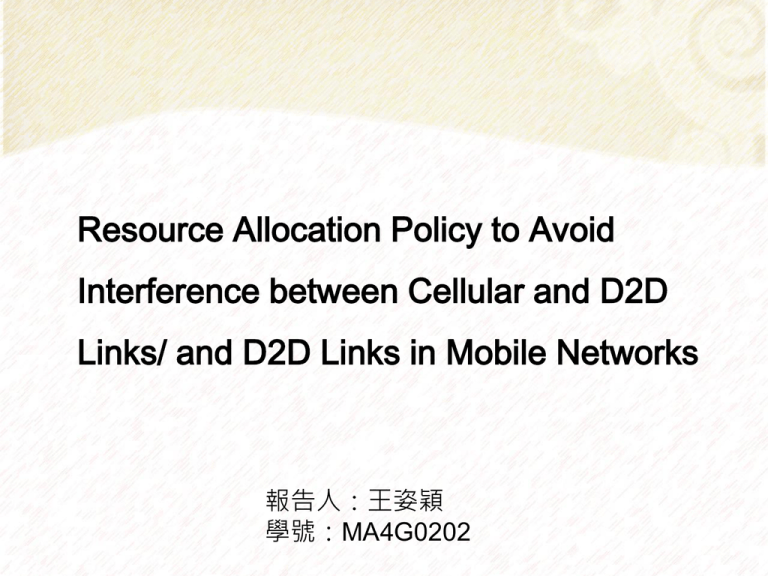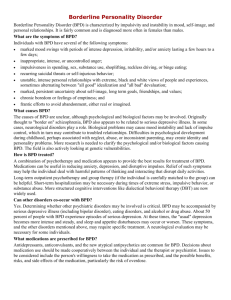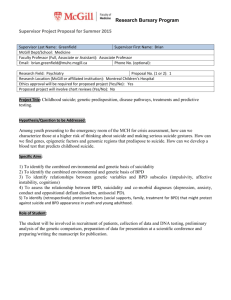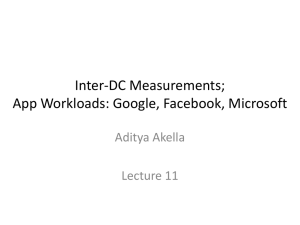Resource Allocation Policy to Avoid Interference between Cellular and D2D
advertisement

Resource Allocation Policy to Avoid Interference between Cellular and D2D Links/ and D2D Links in Mobile Networks 報告人:王姿穎 學號:MA4G0202 Outline 1. Introduction 2. System model 3. How to assign D2D link resource 4. Numerical example 5. Concluding 1.Introduction The goal of this paper is to show how to cope with interferences between D2D and cellular cell and between D2D links. The considered service is limited by D2D commercial advertisement broadcasted by shops in a small area. 2. System model System Model with Frequency Reuse Factor 3 2. System model Frequency Reuse(頻率重複使用) 在整個系統涵蓋範圍內,讓許多基地台使用相同的無線電 頻率同時進行通訊,以増加系統的通訊容量。前提是兩cell 得相距夠遠, 且信號強度不相互干擾。 群組 (cluster) cell 2. System model 可使用頻率 全部頻寬 地區 Allocated Frequency Bandwidth in Each Area 2. System model Interference Model 3. How to assign D2D link resource Step 1 : Interference cancellation between cellular link and D2D link To solve the problem, an additional frequency fraction which considers D2D links as an adjacent cell should be assigned. On one hand interferences from cell edge are effectively eliminated. On the other hand the interferences from users located at cell core still remain un-removed, which can be eliminated with D2D belt. 3. How to assign D2D link resource Step 1 : Interference cancellation between cellular link and D2D link The white area, a frequency band used by D2D link, the center of the cell, but is unavailable for users located at edge of cell center area. Such a frequency assignment can D2D Belt get rid of the cellular link-driven interferences on D2D link. Proposition 1: Even at the center of the cell, if within D2D belt, the frequency band is not available. 3. How to assign D2D link resource Step2 : Interferences cancellation between D2D links The new assignment method owes its key concept to the system information. System information is literally a piece of information for a terminal to attach a base station. Pieces of information are categorized by its nature into a number of system information messages and transmitted from base stations to terminals. From the messages terminals gain the required information to attach base stations. To that end, system information messages are scheduled open only to different sub-frames. By doing so, sub-frames used by D2D links are allocated in a different way. 3. How to assign D2D link resource Step2 : Interferences cancellation between D2D links Basic Assumptions: The AD service through each D2D link is provided for specific amount of time, which is the same for all cells (D2D AD window : w). The AD service through each D2D link is transmitted continuously at a certain interval of T whose definition is a multiple of more than 20ms radio frames (one radio frame = 10 subframes, one subframe = 1ms.) Proposition 2: In order to eliminate interferences between D2D links, different subframes are allocated to each D2D link. 4. Numerical example SUBFRAME ALLOCATION EXAMPLES (R=3, W=2) 1) 2) 3) 4) 5) R = frequency reuse factor i = AD D2D link of cell n=i mod R x=n*w (D2D AD window : w) from the subframe a, the service is provided for the time of w and satisfies a=x mod 10 6) first service is given, continuously at the interval of T,to RF that satisfies RF mod T = FLOOR(x/10) 4. Numerical example The link gain between mobile 𝑖 and store 𝑘, 𝑔𝑖𝑘 is given by . 𝑠𝑖 is shadow fading factor between mobile i and store 𝑘. 𝑑𝑖𝑘 is the distance between mobile 𝑖 and store 𝑘. The shadow fading model is given as log-normal distribution of which standard deviation is 8dB. For the simulation simplicity, the mobiles’ and stores, maximum transmission power is limited by 1 watt. The SINR of D2D link between mobile i and store 𝑘 is give as following: 4. Numerical example Where M is the number of mobiles using uplink channel in cellular system and N is thermal noise. S is the number of stores broadcasting advertisement on D2D links. 4. Numerical example The simulation duration is 100 radio frames. The table shows the average throughput at every radio frame. The average value is derived from 100 experiments. AVERAGE THROUGHPUT IN EACH RADIO FRAME ALGORITHM 1 : SAME RESOURCES ARE SHARED. ALGORITHM 2: ONLY FREQUENCY DIVISION IS USED. 5. Concluding 1. This paper proposes a way of eliminating interferences from D2D links. 2. It is expected to upgrade the system when D2D technologies are fully operational. 3. That the service is limited only to AD and frequency efficiency is low because it is FFR-based are weaknesses yet to overcome, which require further studies.



